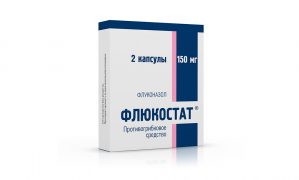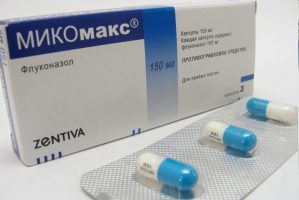"Fluconazole" refers to a group of antifungal drugs. This highly effective drug at an affordable cost is often prescribed by doctors in the complex treatment of many diseases of the mycosis group. Given the high effectiveness in conjunction with the likely side effects and a number of special instructions, the drug can only be purchased with a prescription from your doctor.
Material Content:
Composition, release forms

The medicine is in the form of capsules with the amount of active substance in 50 and 150 mg. The drug has a therapeutic effect due to the main component of the same name. As an auxiliary material, starch and lactose are present in the composition. The shell includes dyes, and the gel retaining component is gelatin.
Pharmacological action and indications for use
Fluconazole tablets are aimed at suppressing the activity of microorganisms, creating conditions unsuitable for their vital functions. Among other things, fluconazole disrupts the natural growth of fungal cells, interfering with the synthesis of lanosterol in ergosterol. Due to such an intervention, cells cannot divide, the structure of cytochrome is disrupted, which means that microorganisms are not able to grow and develop.

The drug is well suited for the treatment of certain diseases, the causative agents of which are certain groups of fungi.
The effect of taking the pills:
- The development and growth of microorganisms is slowed down, and existing ones are gradually dying.
- The inflammatory process is stopped.
- Symptoms subside and complete recovery due to the destruction of the pathogen.
Indications for admission are such diseases in which the causative agent is yeast-like bacteria:
- diseases of the central nervous system;
- infections of the mucous membranes of the oral cavity;
- diseases of the internal organs and reproductive system (e.g. candidiasis).
Also, the drug is used for preventive purposes in oncology and after abdominal operations in order to prevent the activation of "native" fungi, which are temporarily unable to restrain a weakened body.
Usually, the doctor prescribes "Fluconazole" as one of the means in complex treatment. The drug can be prescribed after examination and reliable detection of high fungal activity.
Instructions for use "Fluconazole"
As a rule, the doctor himself prescribes a certain dosage, duration and frequency of taking the medicine, based on the individual characteristics of the patient’s body, type of disease or already taken preventive measures.
Dosage regimen

In the acute course of the disease, the maximum dose is most often prescribed for a single dose. Then the doctor can prescribe a second appointment to consolidate the effect. Re-take the medicine after a week.
Analyzing the overall clinical picture, weight and age of the patient, the susceptibility of the body and other nuances, the doctor prescribes the highest dosage in the range from 200 to 400 mg of the substance at one time.
If the disease proceeds in a chronic form, the course lasts several weeks, and the reception is similar to the previous scheme - once a week. Most often, the largest dosage is also prescribed.
Fluconazole is often prescribed in gynecological practice for candidiasis. How to take fluconazole with thrush: once in a dosage of 150 mg. It is recommended to supplement the treatment course with Fluconazole suppositories for local effects on the pathogen or antifungal ointments.
According to the instructions for use, the capsule must be taken 15 to 20 minutes after eating, washed down with a few sips of clean drinking water. It is impossible to drink this (like any other) medicine with sweet shop drinks, tea or coffee.
On a note. For each person, the result of the medication taken is manifested individually, depending on the overall picture of the disease and the characteristics of the body. On average, the exposure time is from 1 to 24 hours.
The substance performs its function within three days, after which it is gradually excreted from the body.
If the drug is prescribed as a prophylactic, the doctor prescribes the minimum dosage. The medicine is taken once a day, the course usually lasts from several days to a month. The duration of admission is determined by the doctor, it is impossible to independently regulate therapy.
Special instructions for use

At the time of treatment, you need to refuse to take alcohol, even in small quantities at first glance. Alcohol in interaction with fluconazole not only inhibits the positive effect of the drug, but can also cause complications.
Important! If one of the methods was missed, the next in no case should you drink a double dose to make up for the missed.
Pregnancy and lactation
"Fluconazole" is a fairly powerful tool, so it is not prescribed during pregnancy. Only in individual cases can treatment with this drug be possible if the fungal disease is so highly developed that there is a threat to the woman's life. If the doctor decided that the benefit of the treatment will be higher than the likely threat to the growth and development of the fetus, the drug should be taken.

With prolonged use of the drug during gestation, the birth of a child with many different defects is likely, especially if the course of therapy was at the beginning of pregnancy.There are several cases when, after a full course of treatment of mycoses with high doses of fluconazole in the first months of pregnancy, children were born with an underdeveloped skull structure, a modified skeleton, wolf's mouth and other pathologies.
In the lactation period, the use of "Fluconazole" is unacceptable. Its concentration in milk is not lower than the content in the blood of the mother. The substance should not enter the body of the baby.
Use for impaired liver and kidney function
Unfortunately, few patients are aware of existing problems with the liver or kidneys. The reason for this is simple - the symptoms of diseases in the early stages are practically absent or so inconspicuous that people do not notice them.

Reception of "Fluconazole" for kidney disease is unacceptable - These organs are responsible for removing the drug from the body, and a violation in their work will lead to the accumulation of active substances in the blood.
The liver is also involved in the withdrawal of matter, however, to a lesser extent. For diseases of this “filter”, the drug can be prescribed only at the discretion of the treating specialist.
Drug Interactions with Other Drugs
If at the time of prescribing treatment the patient is taking any antihistamines, antifungals, antibiotics, drugs for indigestion, arrhythmias or undergoing treatment for mental disorders, it is necessary to notify the attending physician.

The following effects are likely:
- Taking Fluconazole and Cisapride disrupts the heart.
- The combination with "Terfenadine" leads to arrhythmia.
- The combination with Astemizole or Hindin promotes the development of ventricular tachycardia.
- Erythromycin and Fluconazole collectively cause cardiotoxicity.
Careful monitoring is required by the condition of a person combining the use of "Fluconazole" with anticoagulant drugs, HMG-Coa reductase inhibitors, as well as oral contraceptives.
Contraindications, side effects and overdose

Contraindications are:
- individual intolerance to the drug;
- age less than 3 years;
- disorders in the hematopoietic system.
According to the doctor’s decision, therapy can be prescribed for renal and liver failure, heart pathologies, electrolyte imbalances.
Taking certain drugs may also be a contraindication to treatment with "Fluconazole."
Side effects with improper treatment:
- disruption of the digestive organs, manifesting themselves in painful sensations, lack of appetite, diarrhea;
- symptoms of the nervous system, such as cramps, dizziness, migraine, decreased overall activity;
- disturbances in the work of the heart and blood vessels, such as arrhythmia, ventricular flutter, unnatural increase in blood pressure;
- allergy in the form of a rash and spots on the skin;
- impaired kidney function.
The cause of side effects may be a violation of the prescribed prescription, taking, despite contraindications, a long course of treatment and the body's individual susceptibility to the drug.
Disorders from the kidneys, and sometimes the liver, is due to the fact that it is these organs that are responsible for the removal of drug residues from the body.
Overdose is noted by such signs:
- Bouts of hallucinations.
- The development of paranoia and related patient behavior.
To eliminate an overdose, you need to rinse the stomach cavity, then conduct symptomatic therapy, selected by a specialist, and forced diuresis. Typically, after 3 hours, the fluconazole content in the body drops by about half.
Analogs
Analogues of "Fluconazole" are known as follows:
- Mikomaks. The Czech Republic produces the drug. The cost varies between 230 - 580 rubles, depending on the concentration of the active substance and the number of capsules in one package. The medicine has the form of not only capsules, but also a syrup, as well as a solution for administration through a vein.
- Flucostat. The manufacturer is located in Russia. The price of the drug is about 357 rubles for 7 tablets.For a single admission, 1 to 2 units are issued, tentatively, 190 to 300 rubles each. The manufacturer also offers a solution in the form of a solution that is administered intravenously, with a concentration of 2 mg of substance per 1 ml of solution. The bottle has a volume of 50 ml.
- Diflucan. Manufacturer is USA. The pharmaceutical price is about 920 rubles for 4 capsules with a minimum concentration of fluconazole. The manufacturer offers various forms of release and their volumes for the convenience of the consumer: powders, suspensions and solutions.
- Fluconazole Vertex. Produces Russia. The cost is from 33 rubles per 1 capsule.
- "Fluconazole-teva." The manufacturer is located in Israel. The price is about 180 rubles per capsule of maximum concentration. Smaller dosages are also found, the package may contain from 1 to hundreds of units of tablets.
- "Diflason". It is made in Slovenia. The cost of one and a half hundred rubles with a maximum content of the active component. The plate includes 7 capsules of 50 mg each. The manufacturer offers consumers capsules and solution.
- "Mikosist." The manufacturer is Hungary. The cost of the drug is 582 rubles per plate of 7 capsules of the minimum concentration, and the maximum in the amount of one tablet is estimated at about 308 rubles. Available in the form of capsules of 1, 2, 7, 28 units per pack, as well as in bottles in the form of a solution of 100 ml.
- "Fluconazole Stad." Manufacturer Russia. The cost is from 69 rubles per 1 capsule. Seven-unit packaging is also available.
All the drugs considered are synonymous with "Fluconazole" for the active substance. Some manufacturers offer several forms of their products. However, the feasibility of replacing Fluconazole with another drug should be discussed with your doctor.















